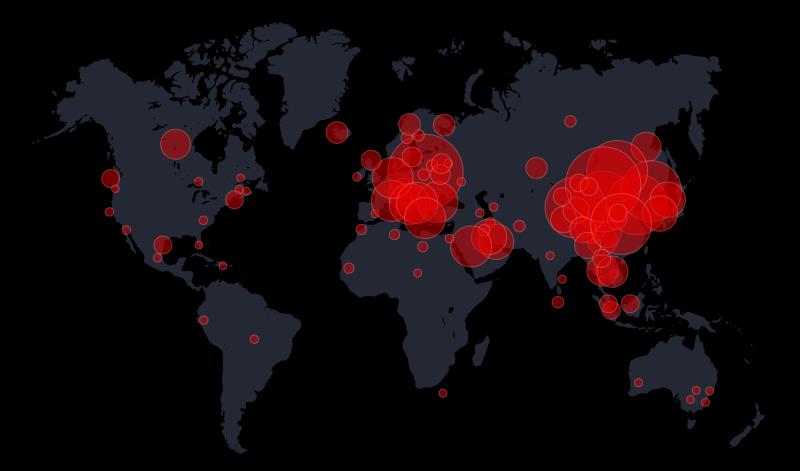
“The coronavirus outbreak involves an emerging virus that’s deadly and rapidly spreading, tens of thousands of cases in dozens of countries … more than 50 million people in cities in China in lockdown, increasing travel restrictions, and currently, no vaccine or treatment for this new virus,” said Brian W. Simpson, editor of the Johns Hopkins Public Health Magazine during a recent panel discussion with experts from Johns Hopkins University (JHU), Washington DC, US. [Novel Coronavirus Panel at the Johns Hopkins Bloomberg School of Public Health, available at https://www.youtube.com/watch?v=cbd-oilmpdU, accessed 18/02/2020]
At time of writing, a total of 105,586 cases of COVID-19 had been confirmed globally, 80,859 of which occurred in China. Singapore had 138 confirmed cases and Japan had 455. Ninety-three cases had been confirmed in Malaysia, and six confirmed in the Philippines. A total of 3,100 deaths had been reported in China, and 484 deaths outside China. [World Health Organization (WHO), available at https://www.who.int/docs/default-source/coronaviruse/situation-reports/20200308-sitrep-48-covid-19.pdf?sfvrsn=16f7ccef_4, accessed 09/03/2020]
The sudden increase of 13,332 clinically diagnosed cases from Hubei on 13 February [WHO, available at https://www.who.int/docs/default-source/coronaviruse/situation-reports/20200213-sitrep-24-covid-19.pdf?sfvrsn=9a7406a4_4, accessed 18/02/2020] was later noted to be due to a change in diagnosis and reporting methods and not to an increase in new infections.
“[W]e understand that most of these cases relate to a period going back over days and weeks and are retrospectively reported as cases, sometimes back to the beginning of the outbreak itself,” said Dr Michael Ryan, Executive Director, WHO Health Emergencies Programme. [WHO, available at https://www.who.int/news-room/detail/13-02-2020-remarks-by-dr-michael-ryan-executive-director-who-health-emergencies-programme-at-media-briefing-on-covid-19-on-13-february-2020, accessed 18/02/2020] “[I]n Hubei province only, a trained medical professional can now classify a suspected case of COVID-19 as a clinically-confirmed case on the basis of chest imaging, rather than having to have a laboratory confirmation.”
“This allows clinicians to move and report cases more quickly, not having to wait for lab confirmation, ensuring that people get to clinical care more quickly, and also allows public health responses in terms of contact tracing and other important public health measures to be initiated,” he said.
Is the worst yet to come?
“I don’t think we have a good sense right now of how many cases we’re not seeing,” said Assistant Professor Caitlin Rivers from the Johns Hopkins Bloomberg School of Public Health, Center for Health Security, at the JHU panel discussion.
At present, about 15 percent of cases reported in China are considered severe. If a vast number of cases are unreported, it would suggest that these patients have mild disease. It would also suggest that the disease itself could be less severe than what it appears to be, she said.
“[In general, we] believe that most of the spread will occur around people who are symptomatic,” said Dr Tom Inglesby, Director, Bloomberg School Center for Health Security. If the disease can be spread by asymptomatic individuals, this could present a problem in terms of controlling the virus. On a more positive note, if asymptomatic spread is already happening, it suggests that many individuals may have already been exposed and yet, are not developing symptoms, and thus, the illness may be milder than thought, he added.
“In general, [with regard to respiratory disease], asymptomatic transmission is generally not the major driver of an outbreak,” noted Dr Anthony Fauci, Director, National Institute of Allergy and Infectious Diseases, in a separate panel discussion conducted by The Aspen Institute. [The Aspen Institute, available at https://www.youtube.com/watch?v=5faOFdMfti8, accessed 18/02/2020] However, it does affect screening and diagnostic policy, he said.
“What we do know is that the disease can be really severe,” said Dr Nancy Messonnier, Director, National Center for Immunization and Respiratory Diseases, Centers for Disease Control and Prevention (CDC), at The Aspen Institute panel discussion. [The Aspen Institute, available at https://www.youtube.com/watch?v=5faOFdMfti8, accessed 18/02/2020]
“We know that the more severe disease is in people who are older and people with underlying illnesses. What we don’t fully know is the full spectrum of illness,” she added. Overestimation of severity is common in the early stages of an epidemic as the reports are of people who have more severe disease. We also don’t know how much mild disease there is, she said.
In a media briefing, Director-General of the WHO, Dr Tedros Adhanom Ghebreyesus, noted the likelihood of severe disease connected to COVID-19. “In about 14 percent of cases, the virus causes severe disease, including pneumonia and shortness of breath and about 5 percent of patients have critical disease including respiratory failure, septic shock, and multi-organ failure. In 2 percent of reported cases, the virus is fatal, and the risk of death increases the older you are,” he said. More than 80 percent of cases are considered mild. [WHO, available at https://www.who.int/dg/speeches/detail/who-director-general-s-remarks-at-the-media-briefing-on-covid-2019-outbreak-on-17-february-2020, accessed 18/02/2020]
Travel restrictions: Yay or nay?
Countries have enacted different travel restrictions in an attempt to curb the spread of COVID-19. In Singapore, for example, with the exception of residents, passengers who have been in the People’s Republic of China, Iran, the Republic of Korea, or northern Italy in the last 14 days are currently not allowed to transit or enter Singapore. [International Air Transport Association (IATA), available at https://www.iatatravelcentre.com/international-travel-document-news/1580226297.htm, accessed 09/03/2020]
It is important to understand the purpose of restricting travel, said Messonnier. If the disease is transmittable by people who are asymptomatic or mildly symptomatic, travel restrictions would not stop the virus from entering a country. In the US, for example, the travel restrictions were essentially to slow down the progression so pandemic preparation could be put in place, she said.
Travel bans will never exclude everyone at risk of spreading the disease, said Fauci. “If you’re trying to keep people out of a country during an outbreak, you will never succeed in stopping it. The only thing you will do is delay it.” The idea was to slow down the importation, particularly from the epicentre of the outbreak, he said.